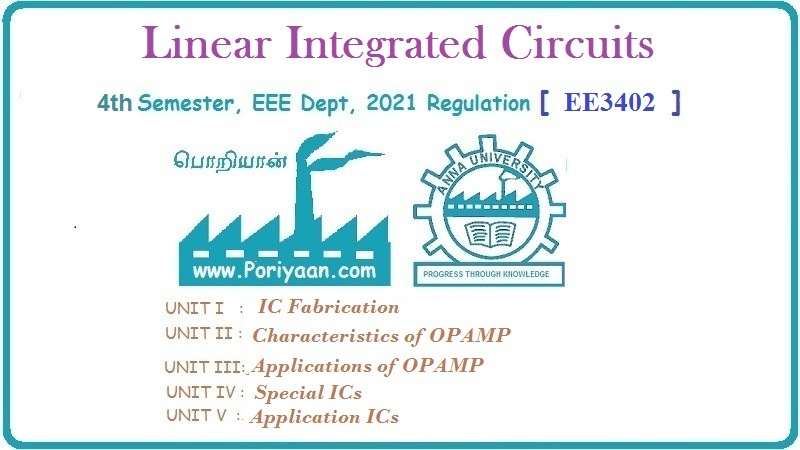Linear Integrated Circuits: Unit III: Applications of Op-amp
Basic Logarithmic Amplifier using Op-amp
Working Principle, Circuit Diagram | Operational amplifier
The fundamental log amplifier is formed by placing a transistor as a diode in the negative feedback path of the op-amp.
Basic Logarithmic Amplifier
May-08,14,
Dec.-08,14,16
The
fundamental log amplifier is formed by placing a transistor as a diode in the
negative feedback path of the op-amp.
1. Basic Log Amplifier using Transistor
The
basic log amplifier can be obtained by using a transistor as a diode in the
negative feedback path of an op-amp, as shown in the Fig. 3.2.1.

The
node B is at virtual ground hence VB = 0.
I
= Vin – VB / R = Vin / R …. (3.2.1)
As
the op-amp input current is zero
I
= IC = Collector current
The
voltage VCB = 0 as the collector is at virtual ground and base is
grounded. Hence we can write the equation of IC as,

The
equation gives the output, proportional to the logarithm of the input voltage Vin
a.
Disadvantages of Basic Circuit
The
reverse saturation current Io for the diode changes with temperature. In fact
it doubles for every ten degree celcius rise in the temperature.
Similarly
the emitter saturation current varies significantly from one transistor to
other and also with the temperature.
Hence
it is very difficult to set the term Vref for the circuit.
The
term VT which is kT also changes with temperature, which appears in
both the equations.
Thus
temperature affects the performance and accuracy of the basic logarithmic
amplifier circuit. Hence it is must to provide some sort of temperature
compensation to reduce the errors.
2. Temperature Compensated Log Amplifier
In
this technique two log amplifiers are used. One of the log amplifiers is given
as a reference voltage Vref while the other is given an input voltage Vin.
The two transistors used in the two log amplifier circuits are integrated close
together in the same silicon wafer. This ensures a close match of the
saturation currents and provides good thermal tracking. The circuit is shown in
the Fig. 3.2.2.

The
transistors Q1, Q2 are fabricated on same chip. The
op-amp A1 and A2 work as the basic transistor logarithmic
amplifiers. For Q1, Q2 we can write,

The op-amp A3 acts as a difference
amplifier with the unity gain.

The
Vref is decided by external battery and it is not temperature
dependent.
The
temperature dependent component Is gets cancelled out.
Still
the term VT is present in Vx which depends on the
temperature. This is compensated by the last stage of the op-amp A4.
It acts as a noninverting amplifier with gain of (1 + R2 / RT)
where RT is the thermistor
having positive temperature coefficient.

As
temperature changes, VT changes but at the same time RT
the ratio VT (R2 + RT) / RT remains
constant.
Hence
assuming this term as K, we can write,
Vo
= Kln (Vin / Vref) …. (3.2.16)
Thus
properly matched coefficients and the resistance values provide a perfect
temperature compensation for the circuit. The output is proportional to the
logarithm of the input and temperature independent.
Review Questions
1. Explain the circuit
operation of logarithmic amplifier using two op-amps with necessary diagrams.
2. Explain the basic
log amplifier using transistor.
3. Derive the
expression for the log amplifier with necessary diagram.
Linear Integrated Circuits: Unit III: Applications of Op-amp : Tag: : Working Principle, Circuit Diagram | Operational amplifier - Basic Logarithmic Amplifier using Op-amp
Related Topics
Related Subjects
Linear Integrated Circuits
EE3402 Lic Operational Amplifiers 4th Semester EEE Dept | 2021 Regulation | 4th Semester EEE Dept 2021 Regulation
